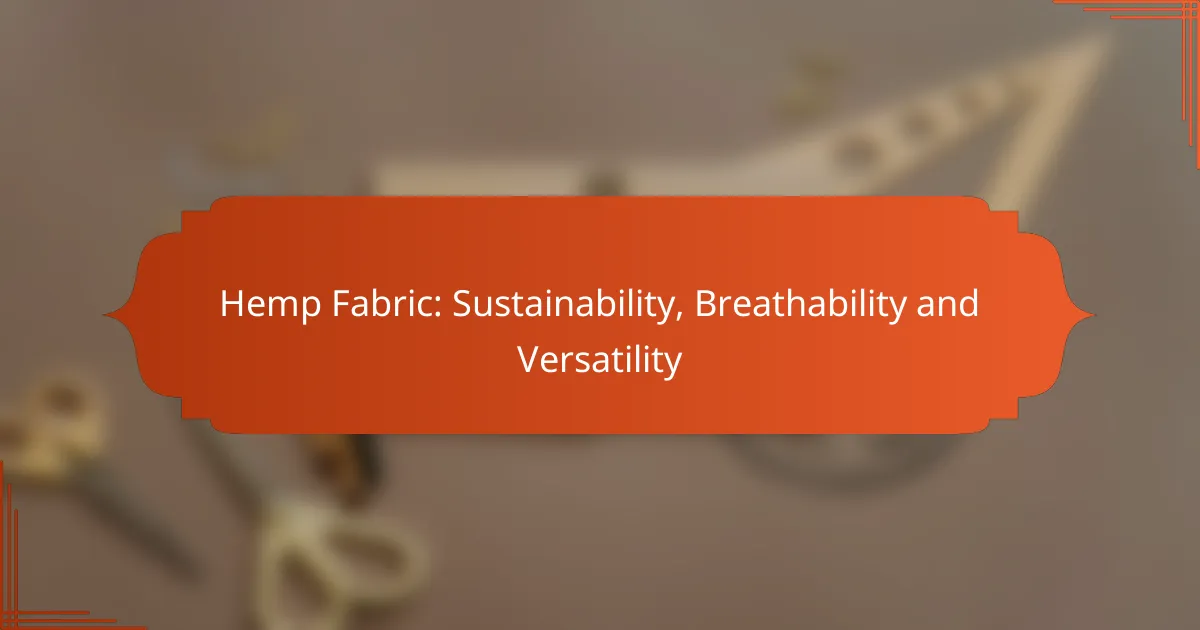Hemp fabric stands out for its sustainability, requiring minimal resources during cultivation and processing while positively impacting the environment. Known for its excellent breathability, it keeps wearers comfortable in various climates by allowing air circulation. Additionally, its versatility makes it suitable for a wide range of applications, from clothing to industrial materials, thanks to its durability and eco-friendly nature.

How is hemp fabric sustainable?
Hemp fabric is sustainable due to its eco-friendly cultivation and processing methods. It requires minimal resources and contributes positively to the environment throughout its lifecycle.
Biodegradable properties
Hemp fabric is fully biodegradable, meaning it can decompose naturally without harming the environment. When disposed of, it breaks down within a few months, returning nutrients to the soil.
This contrasts sharply with synthetic fabrics, which can take hundreds of years to decompose. Choosing hemp over synthetic options helps reduce landfill waste significantly.
Low water consumption
Hemp cultivation requires considerably less water compared to conventional crops like cotton. On average, hemp needs about 50% less water, making it a more sustainable choice in water-scarce regions.
This low water consumption is crucial, especially in areas facing drought or water shortages, as it allows for more efficient use of this vital resource.
Organic farming practices
Hemp is often grown using organic farming methods, which avoid synthetic pesticides and fertilizers. This practice not only protects the soil but also promotes biodiversity by supporting various plant and animal life.
Organic hemp farming adheres to strict regulations, ensuring that the fabric produced is free from harmful chemicals, making it safer for consumers and the environment.
Carbon footprint reduction
The cultivation of hemp helps reduce the carbon footprint due to its ability to absorb significant amounts of CO2 from the atmosphere. A hectare of hemp can absorb approximately 15 tons of CO2, contributing to climate change mitigation.
Additionally, the energy required for processing hemp is lower than that for synthetic fibers, further minimizing its overall environmental impact. By choosing hemp fabric, consumers can support a more sustainable textile industry.

What are the benefits of hemp fabric breathability?
Hemp fabric is known for its excellent breathability, which contributes to comfort in various climates. This natural fiber allows air to circulate, keeping the wearer cool and dry, making it an ideal choice for clothing and textiles.
Moisture-wicking capabilities
Hemp fabric has impressive moisture-wicking properties, meaning it can draw sweat away from the skin. This feature helps to keep the body dry and comfortable, especially during physical activities or in humid environments.
When compared to synthetic fabrics, hemp can absorb moisture without feeling heavy or damp, making it a preferred option for activewear and summer clothing.
Temperature regulation
Hemp fabric naturally regulates temperature, providing warmth in cooler conditions and a cooling effect in warmer weather. This adaptability is due to the fiber’s structure, which allows for air circulation while retaining body heat when needed.
For instance, wearing hemp clothing in both summer and winter can help maintain a comfortable body temperature, reducing the need for multiple layers or heavy fabrics.
Airflow and comfort
The airflow properties of hemp fabric enhance overall comfort by allowing heat and moisture to escape. This characteristic is particularly beneficial for individuals who are active or live in warmer climates.
Choosing hemp textiles for clothing can lead to a more pleasant wearing experience, as the fabric helps prevent overheating and promotes a fresh feel throughout the day.
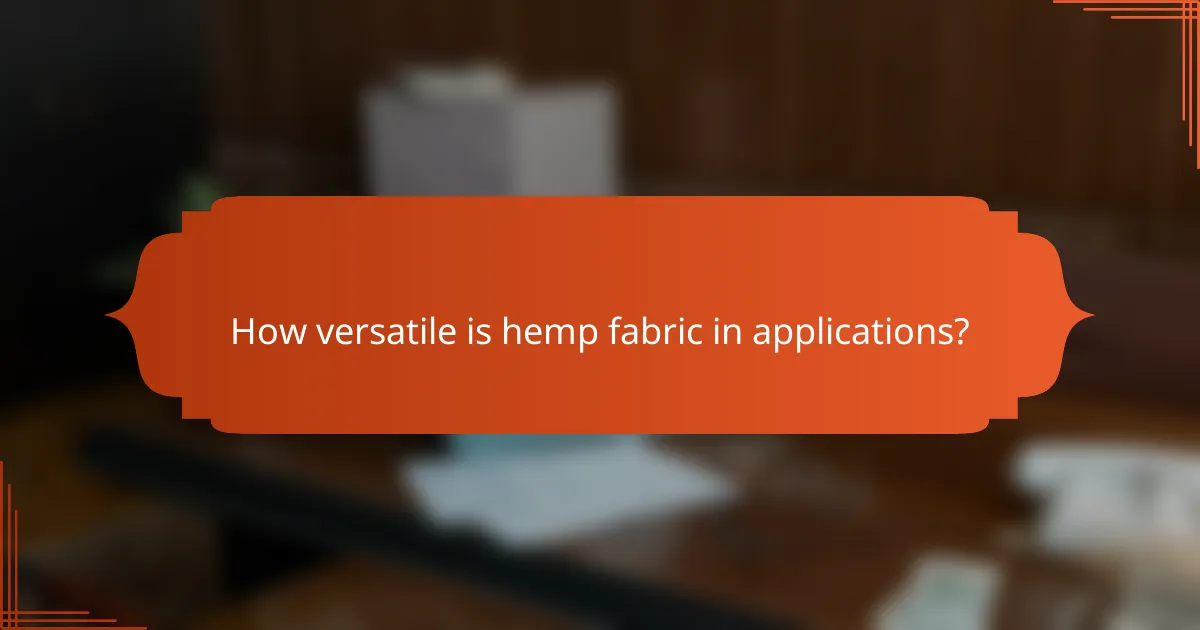
How versatile is hemp fabric in applications?
Hemp fabric is highly versatile, finding use in various applications due to its durability, breathability, and eco-friendliness. From clothing to industrial materials, hemp’s unique properties make it suitable for a wide range of products.
Clothing and apparel
Hemp fabric is increasingly popular in the clothing industry for its strength and breathability. It is often blended with other fibers, such as cotton or lyocell, to enhance comfort and durability. Hemp clothing is known for its natural UV resistance and moisture-wicking properties, making it ideal for activewear and summer garments.
When considering hemp for apparel, look for garments that are labeled as organic to ensure they are free from harmful pesticides. Additionally, hemp’s natural fibers tend to soften with each wash, improving comfort over time.
Home textiles
In home textiles, hemp fabric is used for items like curtains, upholstery, and bedding. Its breathability and hypoallergenic properties make it a great choice for sensitive individuals. Hemp textiles are also resistant to mold and mildew, which is beneficial in humid environments.
For home applications, consider hemp blends for added softness and versatility. Look for products certified by recognized standards, such as Global Organic Textile Standard (GOTS), to ensure sustainability and quality.
Industrial uses
Hemp fabric is utilized in various industrial applications, including ropes, nets, and biodegradable composites. Its strength and resistance to wear make it suitable for heavy-duty uses, such as in construction and automotive industries. Hemp’s low environmental impact also appeals to companies aiming for sustainable practices.
When exploring industrial hemp products, consider the specific requirements of your project, such as tensile strength and environmental conditions. Additionally, check for compliance with industry standards to ensure safety and performance.
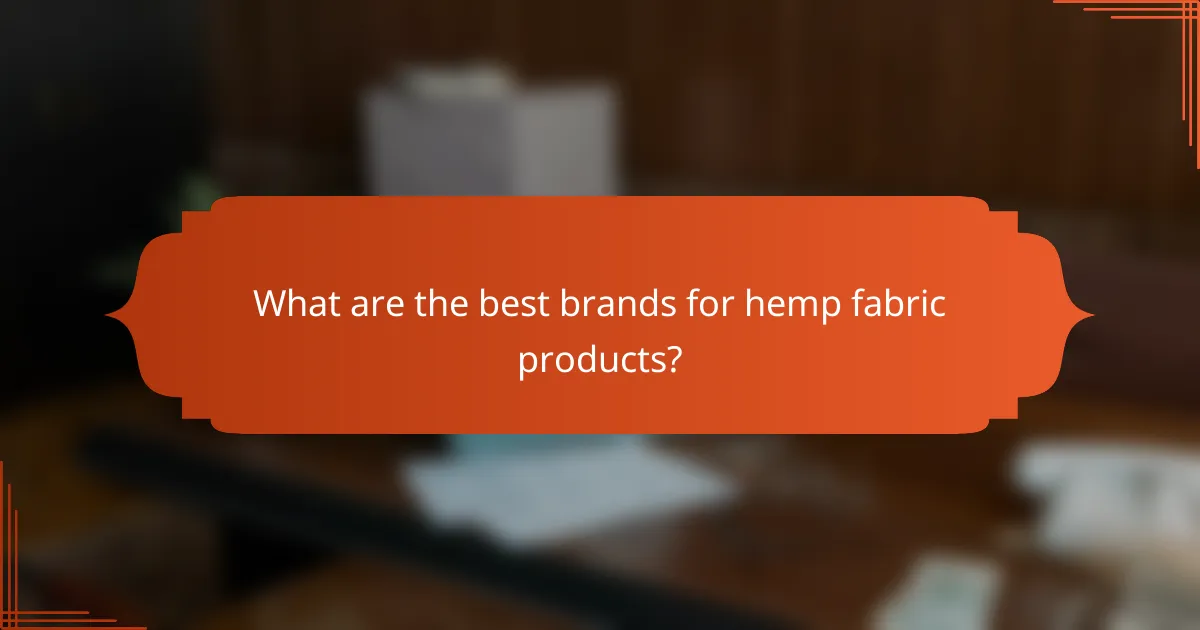
What are the best brands for hemp fabric products?
Some of the best brands for hemp fabric products include Patagonia, Hemp Fortex, and Recreator. These companies are recognized for their commitment to sustainability, quality, and innovative designs in hemp textiles.
Patagonia
Patagonia is a leader in sustainable fashion, offering a range of hemp fabric products that emphasize environmental responsibility. Their hemp clothing is often blended with organic cotton or recycled materials, enhancing durability while maintaining breathability.
When choosing Patagonia, consider their commitment to fair labor practices and transparency in sourcing. Their products typically range from casual wear to outdoor gear, making them versatile for various activities.
Hemp Fortex
Hemp Fortex specializes in high-quality hemp textiles, providing a wide array of fabrics suitable for fashion and home decor. They focus on eco-friendly production methods, ensuring that their hemp is sourced sustainably and processed with minimal environmental impact.
For those looking to purchase from Hemp Fortex, it’s important to note their offerings include both raw fabrics and finished garments. This flexibility allows designers and consumers to choose according to their specific needs, whether for clothing or upholstery.
Recreator
Recreator is known for its stylish and functional hemp apparel, emphasizing comfort and versatility. Their products are designed for active lifestyles, often featuring moisture-wicking properties and breathability, making them ideal for outdoor activities.
When selecting Recreator items, look for their unique designs that incorporate hemp with other sustainable materials. This brand is particularly appealing to those who value both fashion and environmental consciousness in their clothing choices.
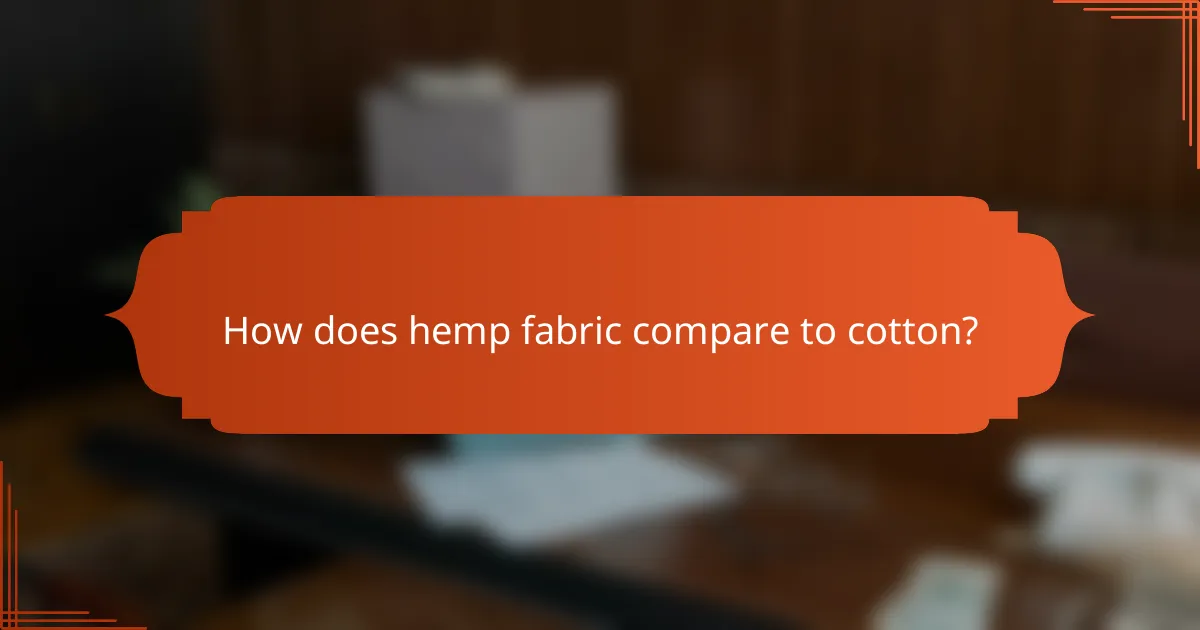
How does hemp fabric compare to cotton?
Hemp fabric is generally more sustainable and durable than cotton, making it a strong alternative for eco-conscious consumers. While cotton is widely used, hemp offers superior breathability and requires less water and pesticides during cultivation.
Environmental impact
Hemp cultivation has a significantly lower environmental impact compared to cotton. It requires less water—often around half as much—and grows quickly, allowing for multiple harvests in a year. Additionally, hemp naturally suppresses weeds, reducing the need for chemical herbicides.
Moreover, hemp fabric is biodegradable, contributing to less waste in landfills. In contrast, conventional cotton farming often relies on harmful pesticides and fertilizers, which can lead to soil degradation and water pollution.
Durability and lifespan
Hemp fabric is known for its exceptional durability, often lasting three times longer than cotton. This resilience makes it ideal for products that undergo frequent use, such as clothing and upholstery. Hemp fibers are strong and resistant to wear, which translates to a longer lifespan for hemp-based products.
In practical terms, this means that while hemp items may have a higher upfront cost, their longevity can lead to savings over time as they do not need to be replaced as frequently as cotton items.
Cost-effectiveness
While hemp fabric can be more expensive than cotton initially, its durability can make it more cost-effective in the long run. The price of hemp fabric typically ranges from moderate to high, depending on the quality and processing methods used.
Consumers should consider the total cost of ownership, factoring in the lifespan and maintenance of hemp products. Investing in hemp can be a wise choice for those looking for sustainable and long-lasting alternatives to cotton.
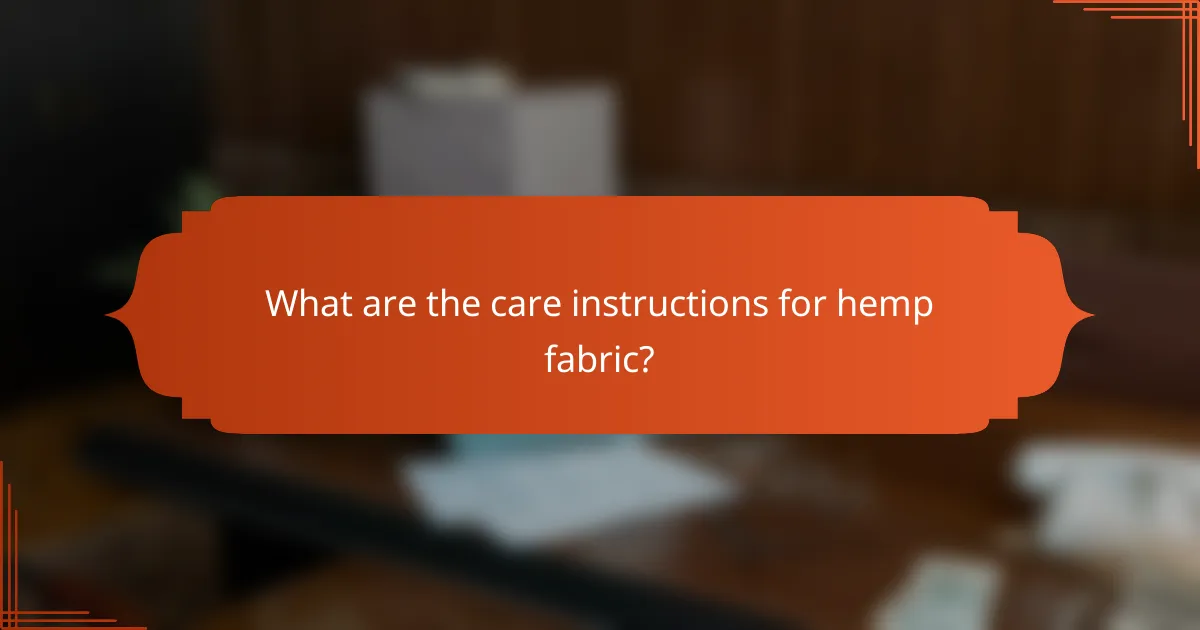
What are the care instructions for hemp fabric?
Caring for hemp fabric is straightforward and helps maintain its durability and appearance. Proper washing and drying techniques will ensure the longevity of your hemp items while preserving their natural qualities.
Washing recommendations
When washing hemp fabric, use cold or lukewarm water to prevent shrinkage and fading. A gentle cycle is preferable, along with mild detergent to avoid harsh chemicals that could damage the fibers.
It’s advisable to wash hemp items separately or with similar colors to prevent dye transfer. For heavily soiled items, consider soaking them in water with a small amount of detergent before washing.
Always check the care label for specific instructions, as some hemp blends may have different requirements. Avoid bleach, as it can weaken the fibers and alter the fabric’s color.
